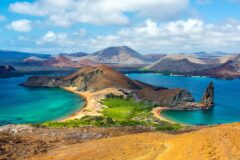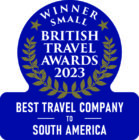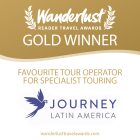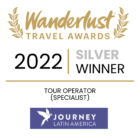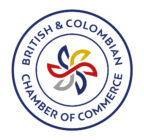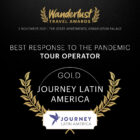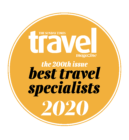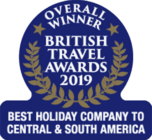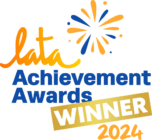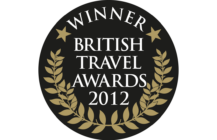Private Journeys
Ecuador’s Andes and Galapagos Islands hop
13 days
from £4,940pp

Overview & Highlights
A good value, economical holiday with small-scale, friendly accommodation. Includes Quito, the Avenue of the Volcanoes, Cuenca and a land-based Galapagos Island adventure with activities and time to relax.
- Walking city tour in Quito
- Hike in Cotopaxi National Park
- Local market visit
- Full day trip to South Plaza Island, Galápagos
- Snorkelling excursion to Kicker Rock, Galápagos
This is an economically priced, imaginative and exciting trip where you will visit both the Andean landscapes on the Ecuador mainland and jet off to the wildlife Mecca of the Galápagos for a stay in cheerful family-run hotels on two different islands.
Begin with a guided exploration of the exquisite colonial core of Quito then set off to explore the Avenue of the Volcanoes, where snow-draped mountains pepper a landscape dominated by the perfect cone of Cotopaxi (5,897m). Drive south, with a stop-off for a walk through pretty countryside and visits to local markets and communities, and a stay in the lively cultural hub of Cuenca. Fly to the Galápagos Islands to stay in welcoming hotels on two of the larger volcanic islands, linked by speedboat.
You’ll immediately be spellbound by the abundance of trusting wildlife, from sea-lions and iguanas to albatrosses and penguins. With a week there based at conveniently-located accommodation you have plenty of time to go out wildlife spotting, snorkelling and sign up locally for activities such as nature walks and kayaking.
Outline itinerary
Day 1
Arrive in Quito; transfer to hotel in the historic centre.
Day 2
Guided walking tour of colonial Quito.
Day 3
Drive to Cotopaxi National Park; guided lake walk.
Day 4
Indigenous Markets and Quilotoa Lake
Day 5
Continue to Cuenca, via Ingapirca.
Day 6
Cuenca city tour and El Cajas National Park
Day 7
Fly to Baltra in the Galápagos Islands and transfer to hotel on Santa Cruz Island.
Day 8
Boat trip to neighbouring islands.
Day 9
Day at leisure on Santa Cruz island
Day 10
By speedboat to San Cristóbal Island.
Day 11
Snorkelling at Kicker Rock.
Day 12
Day at leisure on San Cristóbal Island.
Day 13
Fly to the mainland to connect with your international flight.
Itinerary
Day 1
Arrive in Quito; transfer to hotel in the historic centre.
Transfer to your hotel in the colonial centre of Quito, the Andean capital of Ecuador. The active volcano Guagua Pichincha, to the east, glowers over the dynamic city which, at 2,850m, is one of highest capital cities in the world. Quito is divided into two contrasting districts. The modern zone is characterised by towering glass buildings and houses banks, international companies, hotels, shops and restaurants, while the central colonial area has well-conserved and recently spruced-up white-washed architecture, open air markets and graceful Spanish-style mansions and churches.

Day 2
Guided walking tour of colonial Quito.
Visit the colonial centre of the capital, the first city ever to be named a World Heritage site. High on the agenda is a walk through the main plaza, the Plaza de Independencia, where you will see the government palace, the cathedral, and some of the most important churches built around the 16th and 17th centuries, including the monastery of San Francisco.

Day 3
Drive to Cotopaxi National Park; guided lake walk.
Depart Quito early, driving south to Cotopaxi National Park down the aptly-named ‘Avenue of the Volcanoes’, one of the most scenic routes in Latin America. As its name implies, the route passes an imperial guard of conical snow-draped volcanic cones, surrounded by lush pastures pitted with colonial market towns and tiny indigenous villages. Visit the Cotopaxi Interpretation Centre to learn about the history of its major eruptions as well as its tundra-like vegetation of altitude-resistant shrubs and flowers, over 90 species of bird and variety of hardy mammals.
Later, you will go to Limpiopungo lake (3,850m) and walk around it. If you feel like exploring further, drive to the lower slopes of Cotopaxi and hike to Cotopaxi’s J. Ribas refuge (4,800m – a mountaineers hut located below the snow line) which takes around 2 hours and where you will have a nice view of the volcano and the Andes.

Day 4
Indigenous Markets and Quilotoa Lake
Continue along the Avenue of the Volcanoes with a drive to Quilotoa. Along the way there will be an opportunity to visit one of the indigenous markets, where indians from different places in the locality come together to trade their agricultural goods and buy household necessities. Then visit the volcanic crater at Quilotoa, where you can appreciate a serene, green lake over 200m deep. The 3km-wide caldera was formed by the collapse of the now-dormant volcano following a massive eruption about 600 years ago.
You’ll have the option of a short walk (1.7 km) along the crater’s rim to take in views of the mountain scenery. On the way back, you will stop to visit the galleries of the Tigua community where you can observe the paintings which represent stories from the folklore of this area. You also have the option of attending a painting class given by a local artist.

Day 5
Continue to Cuenca, via Ingapirca.
Depart Riobamba heading south to Alausi. This little highland town would escape under the radar were it not a famous stop along the railway track crossing the Andes from Quito to Guayaquil on the Pacific coast. The most ambitious and spectacular part – named the Devil’s Nose – was restored for visitors and begins right here. The train does not operate on Mondays, Tuesdays or Wednesdays, but on other days of the week it is possible to ride onboard as the train makes its way down the scenic mountainside to Simbambe. It is an enthralling journey and a highly impressive fete of engineering.
Afterwards, continue by road to Ecuador’s most important Inca ruins at Ingapirca. Many of the settlement’s imperial-style structures – residences, storage houses, fortress and tambo (inn) were partially removed by the Spanish invaders but the central structure, the impressive Temple of the Sun, remains intact. Please note Ingapirca is closed on Monday and Tuesday so instead you’ll visit Cojitambo, another important Inca settlement. Continue south to the graceful colonial city of Cuenca.

Day 6
Cuenca city tour and El Cajas National Park
You will be introduced to Cuenca with a guided walking tour of the historic centre. Declared a World heritage site by UNESCO, Cuenca, with its flowery plazas, beautifully renovated churches, cobblestone lanes and museums is a delight to discover. Peruse San Francisco Market, San Sebastian Square, Abdon Calderon Park and two cathedrals. It has earned the nickname ‘Athens of Ecuador’ for its artistic heritage: writers, artists, poets and philosophers have all settled here, and nowadays the congenial ambiance has encouraged the establishment of a thriving expat community. In addition the city is famous for the manufacture of Panama hats – these straw confections originate in Ecuador, not Panama – drop in on a workshop and the Panama Hat Museum ‘El Barranco’.
Then drive to El Cajas National Park (3,600m) – a land of hundreds of lovely lakes and smaller pools. The area is ruggedly beautiful with páramo covering most of the hilly terrain and Quinua trees sheltering in pockets of primary forest. Return to the city to fly from Cuenca to Quito for an overnight stay.
Day 7
Fly to Baltra in the Galápagos Islands and transfer to hotel on Santa Cruz Island.
The Galápagos Islands emerged in the Pacific Ocean 6 million years ago following a spate of volcanic activity and, isolated from the continental mainland, have become home to unique plant and animal species. Without fear of humans, they are sufficiently trusting to allow you to approach them and observe them up close. The islands were the inspiration for Charles Darwin’s theory of evolution, which formed the basis for his revolutionary book ‘On the Origin of Species’, published in 1859.
You spend the first few days of your visit on Santa Cruz, one of the larger islands, with small villages and cattle farms in the interior. Your hotel, Mainao, which started life as a family home, is in a quiet part of the nowadays busy town Puerto Ayora, where you’ll find shops, bars, cafés and small tour operators. It’s just a block or so from the waterfront.

Day 8
Boat trip to neighbouring islands.
Today you cruise to one of the nearby islands, South Plaza. This tiny wedge-shape islet is low and mostly flat, rising to a cliff at one end from where there are good views down into the turquoise water below. The lava here is covered with scrubby vegetation which changes colour according to the time of year: bright green in the rainy season and orange and purple in the dry.
Wildlife is profuse here: iguanas, boobies, frigate birds, tropicbirds, shearwaters vie for space. The channel between this islet and another tiny neighbor is a favourite breeding ground for sea-lions – in fact one of the largest colonies of sea-lions is resident here.
(The island visited may change at short notice depending on local conditions).

Day 9
Day at leisure on Santa Cruz island
Today you are free to explore. You can relax at your hotel or book an excursion locally into the highlands, or to go snorkelling or kayaking. Tortuga Bay – just a stroll from town – has a superb beach, with iguanas and reef sharks waiting to be observed. Giant tortoises roam in the volcanic highlands. There’s plenty of choice of things to do; choose something which suits your personal interests.

Day 10
By speedboat to San Cristóbal Island.
You’ll travel by speedboat across the water to San Cristóbal Island (2 hours), the most fertile in the archipelago, supporting coffee and sugar plantations. Your hotel, is close to the quay in the port, Puerto Baquerizo Moreno, the capital of the Galápagos. It’s a fishing port, but now also has a good infrastructure for visitors, with a growing number of shops and restaurants close to the waterfront.

Day 11
Snorkelling at Kicker Rock.
Kicker Rock is one of the most impressive geological formations in the islands – there are in fact two rocks, jutting skywards in the form of vertical obelisks. Not only are they awe-inspiring enough to be visited just for the sight of them, but they also mark the site of one of the best snorkelling opportunities. Today is likely to be one of the highlights of your holiday.
After a practice run with your snorkelling equipment (supplied) you will be taken to Kicker Rock for some fun in the calm water. This is a superb opportunity to observe an abundance of tropical fish in their kaleidoscopic undersea theatre, and you may well catch sight of stingrays, reef and hammerhead sharks, rays and turtles.

Day 12
Day at leisure on San Cristóbal Island.
Once again you have a day to spend just as you like: your hotel can help you book excursions such as motor launch trips to other islands, diving, kayaking, hiking, bike rides or trips into the interior of the island. You might well be tempted just to relax on a beach (the town beach is reserved for sea-lions, which sometimes venture into town to lounge on a park bench. There are two public beaches to the north of the town.

Day 13
Fly to the mainland to connect with your international flight.
Essentials
Tour info
Transport
2 flights (3.5hrs and 2hrs). 1 speedboat ride (2hrs). 4 road journeys.
Accommodation
You’ll be staying at a mix of colonial style and modern mid-range hotels and countryside lodges.
Meals
Breakfast daily; lunch on days 3, 4 and 8; dinner on days 3 and 4.
Summary Of Nights
13 days, 12 nights: Quito 2, Cotopaxi region 1, Riobamba 1, Cuenca 1, Guayaquil 1, Galápagos Islands 6 (Santa Cruz 3 and San Cristóbal Islands 3).
Currency
The unit of currency in Ecuador is the US dollar.
Budget
It is very difficult to give a guideline for essential expenses, but for meals and drinks not included, you should need roughly an extra $50 per person.
How To Take It
Cash machines are available in Quito, Cuenca, Guayaquil and in the towns of the Galapagos Islands, and so taking a debit or credit card with a PIN number is the most convenient way of withdrawing money while on your trip, and in most shops and restaurants you can also pay by card. However, since cards can get lost, damaged, withheld or blocked, you should not rely exclusively on a card to access funds.
We recommend that additionally you take a reasonable quantity of US dollars cash (no more than is covered by your insurance), which you can spend as the dollar is the local currency. Dollar bills should be in good condition, soiled or torn bills may be refused. You can take sterling or euros, but the exchange rate is not always competitive or even available, restricting the number of places where you can change money.
Tipping
Tips are normally welcomed and expected. Local guides often rely on their tip as a significant proportion of their income. We recommend approximately $US5-10 per person per day for each of guides and drivers, depending on the size of the group.
Insurance
Travel insurance is essential. Details of our recommended policy can be found on our Travel Insurance page.
Airport Taxes
If you have purchased your flights through Journey Latin America, the international departure tax is usually included in the ticket.
Trip Suitability
This holiday is suitable for all able, fit visitors. If you have a disability, please consult us.
Climate
Lying at over 2,500m on the Equator, the highlands have a permanent spring-like climate. The rainy season in the Andes runs between November and April when there are showers most afternoons, so this departure falls in the height of the dry season when the sun is strong during the day, but at night the temperature drops dramatically (maybe as low as freezing point.). Given the proximity to the equator, altitude is the determining factor with regard to temperature. In the mountains at any time of year you should expect a variation between 15°C and 25°C.
In the Galápagos, from January to April it’s hot and the sun is relentless, with some sudden showers. May to July, and October to December is cloudier; August and September it’s often cloudy and cool, and a stiff breeze makes the waters choppier.
Visas
Holders of a full British passport do not require a visa, although passports must be valid for at least 6 months after the trip begins. Anyone with a different nationality should enquire with us or check with the relevant consulate.
If flying to the US, or via the US you will need to fill in your online ESTA application.
Altitude
On the mainland you are staying at high altitude (2,800). A small minority of visitors may suffer temporarily from altitude sickness. Symptoms vary; most common are mild headaches, slight nausea and breathlessness. If you don’t recover in a day or two speak to our representatives; in very rare instances it is necessary to descend to lower altitudes. Most people are unaffected and if you drink plenty of water and allow your body to acclimatise (don’t exert yourself or drink alcohol) in the first couple of days after arrival, you will minimise your chances of suffering any symptoms.
Please refer to our Briefing Dossier for further information.
Clothing And Special Equipment
You should go prepared to encounter all seasons. A light fleece jacket and a waterproof waterproof/breathable shell makes a good combination for highland regions. You will need good walking boots, waterproof trousers, scarf, hat and gloves. In the Galápagos, you will encounter warm weather; summer clothing is appropriate but you may wish to protect your naked skin from the powerful sun.
Sun screen and sunglasses are also highly recommended.
Don’t forget your binoculars, camera, charger and cards.
Please get in touch with the office before departure if you have any doubts. Good equipment is very important and hard to come by in South America.
Vaccinations
Preventative vaccinations are recommended against the following: typhoid; polio; tetanus; hepatitis A. You should consult your GP for specific requirements such as malaria prophylactics. For admission to the Galápagos a yellow fever certificate is required for anyone over 1 year old coming from an area with risk of yellow fever transmission. You can also find helpful information on the Masta Travel Health website.
Cases of Zika virus have been reported in parts of Latin America. If you’re pregnant, or planning to be, you should follow the advice of the National Travel Health Network and Centre
What's included in the price
- Qualified bilingual local guides
- All land transport
- Accommodation as specified
- Meals as specified
- Excursions as specified
- Galapagos National Park and Ingala Fee
Included Excursions
- Walking city tour in Quito
- Hike in Cotopaxi National Park
- Local market visit
- Full day trip to South Plaza Island, Galápagos
- Snorkelling excursion to Kicker Rock, Galápagos
What's not included in the price
- Tips and gratuities
- Meals other than specified
- Entrance fees on included shared excursions
- Optional excursions
